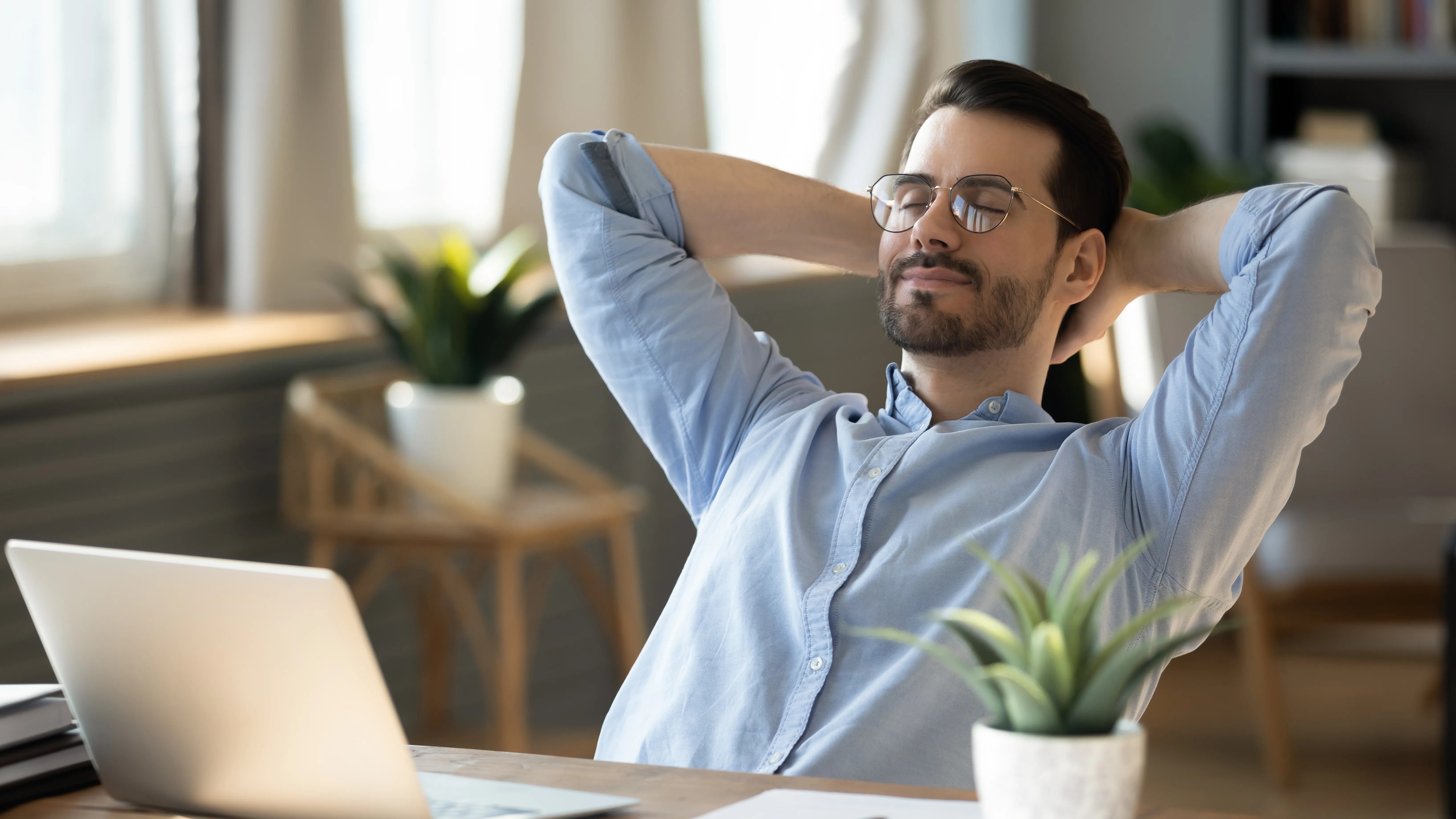Psychology•March 1, 2023
Grounding Techniques for Anxiety
Anxiety is a perfectly normal emotion, but it can also be overwhelming. If the negative thoughts and feelings resulting from anxiety are a constant part of your life, impair your daily functioning, introduce stress, or cause panic attacks, there are practical solutions to help.
Grounding is a technique commonly used to reduce stress and anxiety. Read on to learn how to engage your senses to connect with the present moment, lower your levels of anxiety, and find inner peace.
Grounding Techniques for Anxiety: Simple and Practical Solutions for Stress Relief

Grounding techniques can help you reconnect with the present moment and find inner peace.
Does grounding help with anxiety?
Grounding exercises can help you bring your attention to the present moment, helping you become calmer and more centered. These grounding techniques work by shifting your focus away from anxious thoughts and feelings and toward physical sensations and experiences.
Anxiety is characterized by nervousness, fear, and intense, persistent, and excessive worries. Grounding can help with these and other common symptoms of anxiety, such as
- restlessness
- increased heart rate and sweating
- excessive and persistent worry
- trouble sleeping or staying asleep
- shortness of breath
- difficulty concentrating
- irritability or feelings of anger
- nausea, or digestive problems
All grounding techniques are fundamentally mindfulness techniques. These techniques aim to reduce anxiety and bring your mind and body back to a state of equilibrium and peace by facilitating a reconnection with the present moment. A scientific review including 19,000 studies showed that mindfulness is beneficial for mental health and can reduce the symptoms of depression, anxiety, and pain.¹
What are good grounding techniques for anxiety?
There are several popular grounding techniques ranging from breathwork to simply engaging with your senses. Take a look at the specifics of some of these techniques and how you can incorporate them into your life.
What are the benefits of Deep Breaths?
Taking deep breaths is a simple and effective way to reduce your feelings of anxiety. This involves taking slow, deep breaths and focusing on the sensation of air as it moves in and out of your body. Studies show that slow breathing helps synchronize brain waves, allowing diverse brain regions to communicate effectively.² A scientific review revealed that breathwork could be especially helpful for individuals who experience anxiety and stress.³
What is Mindfulness Meditation?
Meditation involves focusing your attention on your breath and observing what comes into your field of awareness - including thoughts, feelings, and physical sensations - without judgment. While paying attention to the stimuli that enter your field of awareness, there should be no attachment to a particular thought, feeling, or sensation. After observing these stimuli, there is simply a return to your breathing. Research has shown that meditation can improve your sleep and immunity, lower your heart rate, and reduce stress and anxiety.⁴⁻⁵
What are the benefits of Progressive Muscle Relaxation?
This technique aims to improve your awareness of physical sensations in the body by tensing and relaxing different muscle groups. You might start by tensing the muscles in your forehead for 10 to 15 seconds, becoming mindful of the increased tightness and tension in the area. Then, release the tension and let the muscles relax as you count for at least 30 seconds until the area feels entirely at ease. From there, you may move on to another area, such as the jaw or shoulders, to immerse yourself in the experience of your body.
What is Sensory Grounding?
Engaging your senses is an efficient way to ground yourself. This could involve actively listening to music, wiggling your toes, focusing on how the hair on your scalp feels, or noticing the weight of your shirt on your shoulders.
How does the 5 4 3 2 1 grounding technique help you?
This technique involves taking a few deep breaths and then identifying five things you can see, four things you can touch, three things you can hear, two things you can smell, and one thing you can taste. This exercise engages your senses and helps you get in touch with the present, which can be highly useful in stressful situations.
What is the 3 3 3 rule for anxiety?
The 3-3-3 rule for anxiety is a simple grounding technique similar to the 5-4-3-2-1 technique, which can help quickly reduce feelings of stress. This one involves finding three things you can see, three things you can touch, and three things you can hear in your current environment. By the time you’ve finished this exercise, you will have hopefully reconnected with the present and prevented escalated feelings of anxiety.
Regardless of the technique you choose, the important thing is to integrate these into your daily life and routines in order to proactively manage symptoms of anxiety.
What foods reduce anxiety?
Some evidence suggests that specific foods, drinks, and nutrients can lower your anxiety levels. Here are a few examples:
- Foods high in magnesium: Magnesium is an important mineral. It is part of many processes in the body, and is capable of regulating the nervous system to lower your stress levels and help you relax. Foods that are high in magnesium include nuts, dark leafy greens, seeds, and whole grains.
- Probiotics: These are beneficial bacteria that can support the gut-brain axis and a healthy microbiome, shown in studies as linked to better mental health. Probiotics can also reduce inflammation and raise the levels of mood-boosting neurotransmitters such as serotonin. Examples of foods high in probiotics include yogurt, kefir, and kimchi.⁶
- Foods high in Omega-3 fatty acids: A diet rich in Omega-3 fatty acids, such as EPA and DHA, has been linked to lower anxiety rates. Research suggests that those fatty acids reduce inflammation and prevent the dysfunction of brain cells, which can occur in the case of people suffering from anxiety. Foods high in Omega-3s include salmon and chia seeds.⁷
- Chamomile: This is an herb used for tea that, according to research, has antioxidant and anti-inflammatory properties, which can lower inflammation levels in people suffering from anxiety.⁸This is important, as those suffering from anxiety tend to exhibit high levels of inflammation in their bodies, as choric stress can trigger an immune response that leads to inflammation.
- Green tea: This tea contains an amino acid called L-theanine which, based on various studies’ findings, is associated with beneficial effects for brain health and anxiety.⁸
Gradually introducing these foods into your diet could help lower your stress levels and improve your overall health.
Creating a Personalized Grounding Toolkit
Having a wide range of techniques at your disposal is important for managing stress. Creating a personalized toolkit of techniques, such as the techniques we’ve mentioned here, can help you feel more prepared and in control when feeling anxious.
The creation of this personalized toolkit can help you to integrate the techniques into your daily routine. You might make a habit of taking a few deep breaths before you start working or listening to music while you wash dishes. In order to have significant results, it is essential to practice your chosen techniques consistently.
Seeking Support from Mental Health Professionals
Grounding techniques can efficiently diminish your feelings of anxiety, but they might not be sufficient in all cases. If you are struggling with persistent feelings of anxiety, panic attacks, or impaired daily functioning due to your symptoms, you should consider seeking help from a mental health professional.
A therapist or counselor can help you by developing a comprehensive treatment plan, including grounding techniques and evidence-based therapies such as Cognitive-Behavioral Therapy (CBT) or exposure therapy.
Practical Solutions for Stress Relief

Free yourself from stress by engaging with your senses and acknowledging the present moment.
Grounding techniques are simple and pragmatic solutions for managing your anxiety levels. By engaging your senses, you can bring your mind and body back to equilibrium and peace and reconnect with the present moment.
Incorporating grounding techniques into your daily routine and creating a personalized toolkit can help you prepare for situations that could trigger an anxiety attack. Nevertheless, if you feel like you are overwhelmed by feelings of stress and anxiety over a long period of time, you should consult with a mental health professional to receive the support you need.
If you want to learn more about stress-management techniques and how to help people suffering from anxiety, check out our Graduate School of Psychology or speak with an Admissions Advisor to learn more about our programs.
References
- Goyal, M., Singh, S., Sibinga, E. M., Gould, N. F., Rowland-Seymour, A., Sharma, R., ... & Haythornthwaite, J. A. (2014). Meditation programs for psychological stress and well-being: a systematic review and meta-analysis. JAMA internal medicine, 174(3), 357-368.
- Hsu, S. M., Tseng, C. H., Hsieh, C. H., & Hsieh, C. W. (2020). Slow-paced inspiration regularizes alpha phase dynamics in the human brain. Journal of Neurophysiology, 123(1), 289-299.
- Fincham, G. W., Strauss, C., Montero-Marin, J., & Cavanagh, K. (2023). Effect of breathwork on stress and mental health: A meta-analysis of randomised-controlled trials. Scientific Reports, 13(1), 432.
- Rusch, H. L., Rosario, M., Levison, L. M., Olivera, A., Livingston, W. S., Wu, T., & Gill, J. M. (2019). The effect of mindfulness meditation on sleep quality: a systematic review and meta‐analysis of randomized controlled trials. Annals of the New York Academy of Sciences, 1445(1), 5-16.
- Barrett, B., Hayney, M. S., Muller, D., Rakel, D., Ward, A., Obasi, C. N., ... & Coe, C. L. (2012). Meditation or exercise for preventing acute respiratory infection: a randomized controlled trial. The Annals of Family Medicine, 10(4), 337-346.
- Kim, B., Hong, V. M., Yang, J., Hyun, H., Im, J. J., Hwang, J., ... & Kim, J. E. (2016). A review of fermented foods with beneficial effects on brain and cognitive function. Preventive nutrition and food science, 21(4), 297.
- Polokowski, A. R., Shakil, H., Carmichael, C. L., & Reigada, L. C. (2020). Omega-3 fatty acids and anxiety: A systematic review of the possible mechanisms at play. Nutritional Neuroscience, 23(7), 494-504.
- Amsterdam, J. D., Li, Q. S., Xie, S. X., & Mao, J. J. (2020). Putative antidepressant effect of chamomile (Matricaria chamomilla L.) oral extract in subjects with comorbid generalized anxiety disorder and depression. The Journal of Alternative and Complementary Medicine, 26(9), 815-821.
- Hidese, S., Ogawa, S., Ota, M., Ishida, I., Yasukawa, Z., Ozeki, M., & Kunugi, H. (2019). Effects of L-theanine administration on stress-related symptoms and cognitive functions in healthy adults: a randomized controlled trial. Nutrients, 11(10), 2362.
Learn More
Interested in learning more about the programs at Meridian?
Contact An Advisor »Attend an Info Session »



Submitting
Stay Inspired
Receive exclusive content on personal and professional transformation via email with expert insights in psychology, leadership, education, and more.
We don’t email frequently and you can always unsubscribe. By continuing, you are agreeing to Meridian’s Privacy Policy.